Scratch Black Death Original Design / Scratch Built
Scratch - Black Death {Scratch}
Contributed by John Partridge
| Manufacturer: | Scratch |
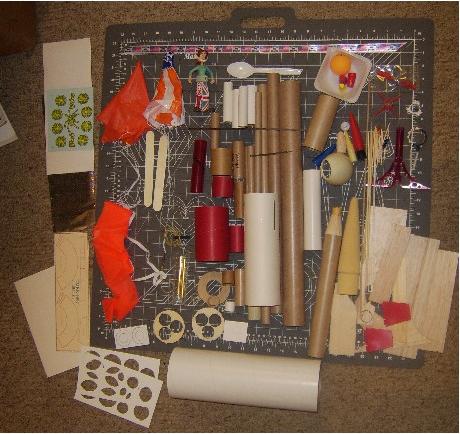
Since there was not a lot of fin material in my box and since there were a lot of large body tubes, I immediately thought of building a tube fin or ring fin rocket. At the same time, I had plenty of smaller BT sizes and a few smaller nose cones so I wondered about using smaller BT's in the center of the large BT's and making them appear to look similar to a jet aircraft engine. The center ring fin tube is 3.6 in. and 4 in long and each of the outboard ring fins are 2.6 in diameter although one is a BT and the other is a coupler for the same size tube so it is a little smaller. Both are 4 in. in length. The main tube is BT-60 but there wasn't enough to make the design I wanted stable so I cut a 5 in length separate from the main section (13-3/4").
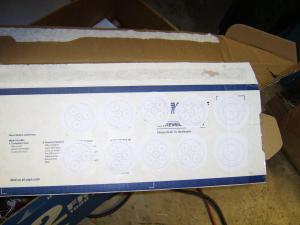
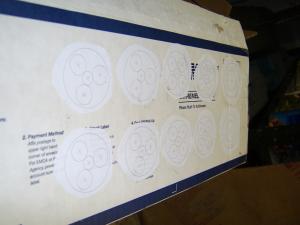
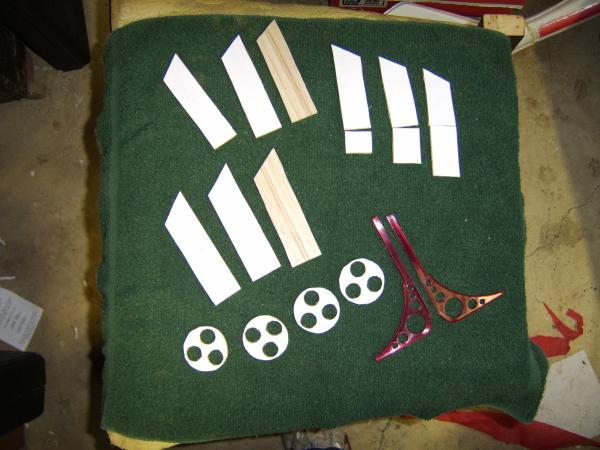
The spacers which hold the BT's in the center of the ring fins are 4" long and approximately 15/16" (outboard) wide or 1-1/16" (center) wide. I made a template for each size and traced it onto typing paper that was glued to the balsa. As a result, they all came out larger than the template and had to be sanded to fit. Some of the spacers had to be laid out and assembled in pieces in order to use every square inch of available fin stock. I aligned the spacers on the BT's and the fins and on the CR's by printing out fin guides using the tool downloaded from EMRR in the Engine mount template Generator. One of these tools was also used to print out CR's and engine blocks on typing paper. This was then glued to the box everything came in and cut out. I actually designed Black Death to be able to fly on 'E' motors with 'C' motors in the side pods but there were two problems. First, unless I get to a club launch I don't have a system that will reliably ignite a cluster, and second, I accidentally assembled one of the side pods backwards so the engine block is too close to the rear of the pod.
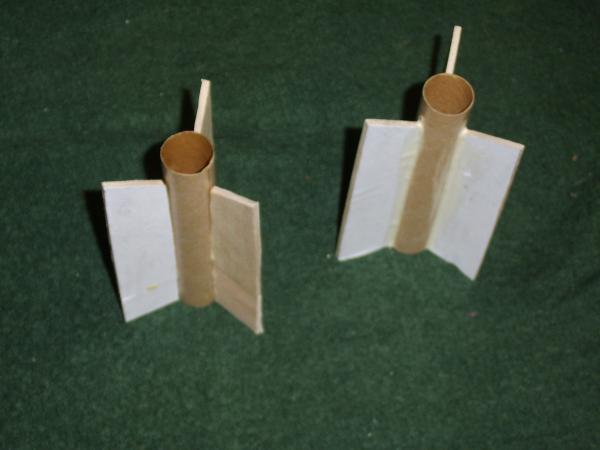
The nose cone for the BT-60 was made of some kind of foam and after making cardboard cutouts (top view and side view) to find the CP, I needed a lot of nose weight to get the CG where it needed to be. The assembled rocket (without paint) weighed about 5 ounces and to get the CG where I felt it was safe I drilled a half inch hole 4" deep in the NC and dropped in a piece of steel rod and a large lead tire weight so that the NC was also 5 oz. These were then epoxied in and the eyelet was screwed into both the epoxy and the lead weight. For the 18mm engine mounts I did not have matching NC's but did have two smallish ones that were similar so I whittled a balsa cone down to nearly match a plastic one that resembled a space shuttle SRB cone.
In order to lengthen the main BT, I made four CR's that held three 13mm BT's. One BT was glued on each end and a second 1.5 inches in from the end. This allowed me to lengthen the BT by an additional 4-1/4" as well as adding an interesting look. I painted these tubes so that they look to be glowing and refer to them as the plasma conduits. At the top of this assembly I drilled a hole in the center of the top CR and passed a length of Kevlar through it, looped it around one tube and tied it off. This is one place I may have cheated. I forgot that I had Kevlar in my Box-o-parts and used some of mine, only finding the boxed Kevlar later after it was impossible to replace in the assembly. The second place I stretched the rules was when I checked the assembled rocket for being straight. I found that the plasma conduit assembly was crooked and as a result, the nose of the rocket was not completely in line with the back. Trying to fix it, I removed the 5" section of BT at the top and replaced it with a new section of my own, exactly the same length as the original. It didn't work. The final assembly had nearly the same bend to it as the original despite leaving it overnight with three hammers on top to keep it pressed against a flat surface while the new glue dried.
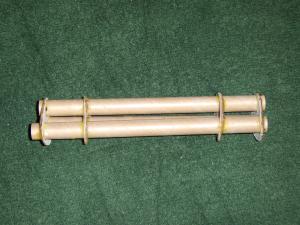
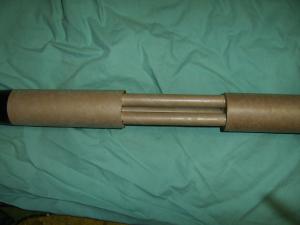
The main fins are 3-15/16" wide and 4' long (to match the ring fins) with a 1-3/4 pitch over the 3-15/16". The top fins are triangular balsa that is 2-3/4" by 1-5/8", the bottom fins are plastic TTW fins from some other project, and the decorative side fins appear to have been some kind of French curve or plastic template of some kind. It was symmetrical so I cut it in half and had fins with an interesting look if not a particularly aerodynamic shape.

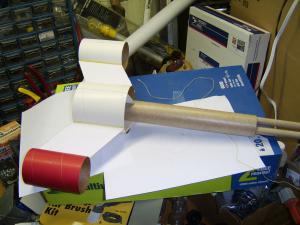
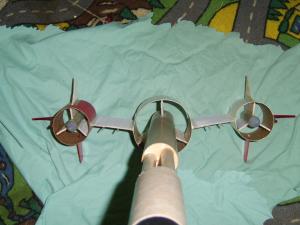
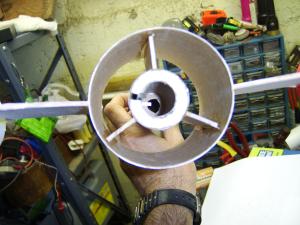
For recovery there was just way too much rocket for the small parachutes that I found in my box but since the nose cone and the rocket were similar in weight, I attached one chute to the NC and the second at the end of the Kevlar shock cord (before the elastic shock cord) so that each one could bear the weight of a separate section.
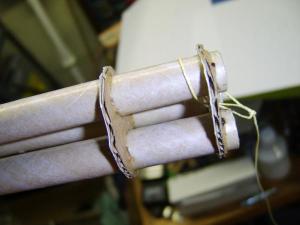
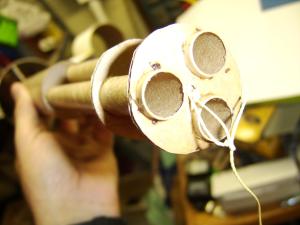
I chose the name Black Death because there were decals from a Black Widow in my Box-o-Parts and I had considered using some of them. I settled on naming the rocket either Black Death or Widow Maker simply because having a Black Widow so very different from the original might require too much explanation.
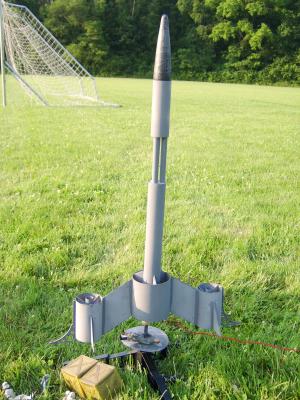
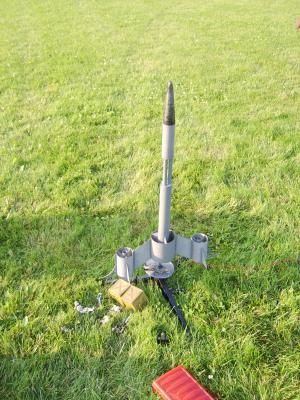
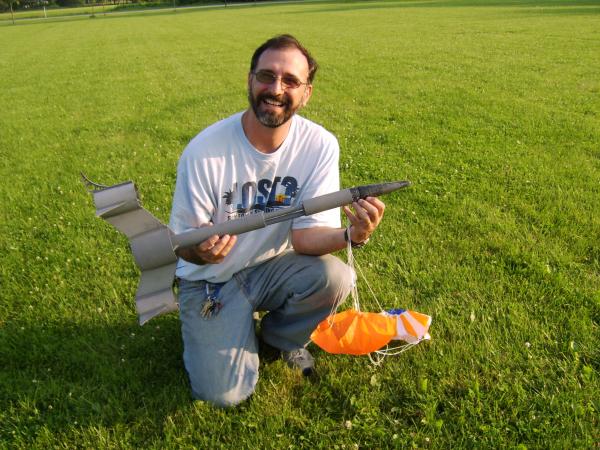
I flew Black Death unpainted (primer only) on a D12-3 motor and a spacer (since it is designed to hold an 'E' motor. I considered trying to fly on an 'E,' but the simulations say that an E-9 would a shade too slow off the pad without motors in the outside pods. The simulation (Alticalc) suggested that I could expect an altitude of over 250 ft. and I was not disappointed. With the odd bend in the main BT, I fully expected that Black Death might just arc over and die as the pilot's Widow Maker but despite its odd bend, Black Death flew perfectly straight and got every bit of it's predicted altitude. Both parachutes deployed perfectly but the motor still managed to get burped after separation. With the motor separating from the rocket, I feel very lucky that I got a good deployment and didn't get a ballistic recovery.
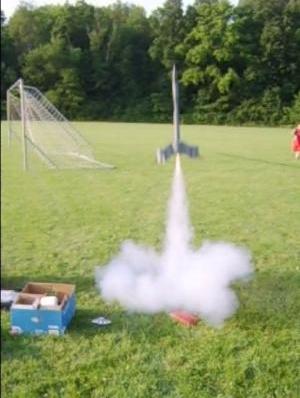
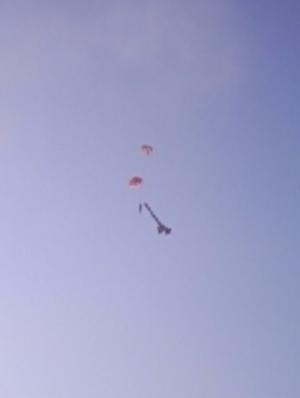
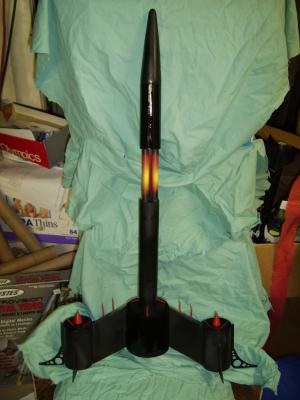
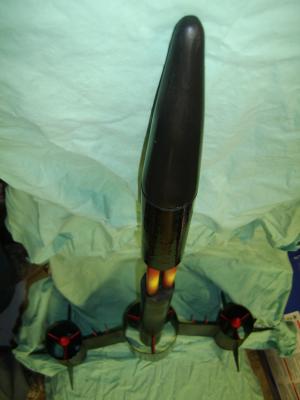

Sponsored Ads
 |
 |











